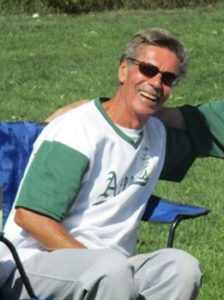Carl’s Story
Carl Fiamelli – Whipple Survivor November 3, 2017
(Whippled at age 69 – Stage 3b Pancreatic Cancer)
“Stay positive, stay strong, believe that you will survive, and hopefully you will inspire others to do the same”
*Carl originally published his story on Hamiltonnews.com (Ontario,Canada)
I am writing this for anyone going through the same battle or who may know someone who is.
Exactly one year ago, I acquired a severe case of jaundice and yellowing of the skin. In addition, I had abdominal pain and itchiness all over my body. During a recommended ultrasound, I was ordered to go to St. Joseph’s emergency ASAP. During a 22-hour stay there, I had an MRI and, the following morning, a doctor confirmed my worst nightmare. I was diagnosed with pancreatic cancer.

I was referred to the Juravinski three days later for an ERCP, a procedure where a bendable lighted tube (endoscope) is placed through your mouth and into your stomach and duodenum. During this operation, a small plastic tube is placed through the cancer to unblock it. In addition, X-rays are taken to study the pancreas and a sample of the cancer is taken for a biopsy. Cancer had blocked my bile duct and prevented bilirubin from flowing out my body. I had six times the normal amount and this caused the jaundice and itchiness.
Two weeks later the diagnosis was confirmed: stage 3B pancreatic cancer.
The surgeon who performed the ERCP, Dr. Michael Marcaccio, felt that I was a good candidate for the Whipple procedure. This is an eight-hour operation with three surgeons who remove the head of the pancreas, part of the duodenum, the lower bile duct and the gallbladder. The remaining bile duct and pancreas are reconnected to the small intestine. The average hospital stay after Whipple is two weeks, but I was home in five days. I had a 13-inch incision held together with 33 metal staples. I believe that this gifted surgeon saved my life. Without this operation, I was given 18 months before I would die.
It should be noted that this operation would cost $100,000 in the U.S. Here in Ontario, I simply provided my OHIP card.
After two months of healing, my chemotherapy commenced. It was a strong combination of oxaliplatin and capecitabine. I was to get one injection every three weeks, plus pills in the interim for a six-month period. Chemo is cumulative in that the first few treatments are tolerable, but once you reach the midpoint, severe symptoms, such as nerve damage, start to develop.
Even though I had many offers from friends and family to accompany me to my chemo injections, I chose always to go alone. It was just something that I wanted to do by myself even though all the other patients had a companion or two.
Chemo makes you very sensitive and vulnerable to cold weather, and you must prepare yourself for the winter months. One very cold morning, a day after my chemo treatment, I had to go to the Juravinski for an appointment. I neglected to cover my nose and mouthy adequately and I collapsed on the hospital floor just as I entered. My larynx stopped working.
I discovered what a code blue was that day.
My chemo is finished now, and after a CT scan, blood tests and a colonoscopy, I appear to be cancer free.
Although I am very happy and optimistic, I remain vigilant. Pancreatic cancer still has a very high mortality rate, especially with lymph node infection, which I had.
Having said that, I still managed to play five games of baseball in the Ancaster Vets Slo Pitch league this summer. This was both physically and emotionally therapeutic for me and I am determined to play again next year.
In conclusion, the one common theme that I heard from everyone was that your attitude is crucial in this battle.
Stay positive, stay strong, believe that you will survive, and hopefully you will inspire others to do the same.